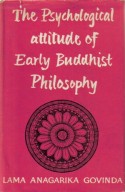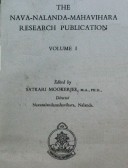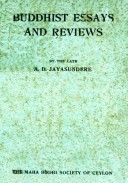Tìm Sách
Sách tiếng Anh-English >> The Psychological Attitude of Early Buddhist Philosophy
Thông tin tra cứu
- Tên sách : The Psychological Attitude of Early Buddhist Philosophy
- Tác giả : Lama Anagarika Govinda
- Dịch giả :
- Ngôn ngữ : Anh
- Số trang : 191
- Nhà xuất bản : Rider-London
- Năm xuất bản : 1961
- Phân loại : Sách tiếng Anh-English
- MCB : 1210000004835
- OPAC :
- Tóm tắt :
INTRODUCTION
Before speaking about Buddhist philosophy I want to make clear the position of Buddhism as well as what I mean by philosophy. It has become a fashion to call Buddhism a philosophy pure and simple or to identify it with one or the other of its branches: psychology and ethics. But Buddhism is something more, otherwise it would have remained merely a matter of aesthetic pleasure for a few beaux esprits, philosophers, and historians, and – in the most favourable case – the rule of conduct for a small group of puritans. Philosophies and scientific systems of psychology have never been able to exercise a dominating influence on the life of humanity – not because there was something wrong with them as systems, nor because they were lacking in truth, but because the truth contained in them was only of theoretical value, born by the brain and not by the heart, thought out by the intellect and not realized in life. Apparently truth alone is not sufficient for exercising a lasting influence on humanity; in order to do that it must be combined with the quality of life. Abstract truth is like tinned food without vitamins. It satisfies our taste and keeps up our body for some time, but we cannot exist on it in the long run. This quality of life is provided for our mind by the religious impulse that urges and guides man towards realization. There is no doubt – the history of Buddhism proves it – that this quality is as strongly present in Buddhism as its philosophical qualities. (The reason why some people hesitate to call Buddhism a religion is that they confound religion with dogma, organized tradition, faith in a divine revelation and similar things, which certainly cannot be found in the Buddha’s teaching).
If, therefore, we speak of Buddhist philosophy we should be conscious that this is only the theoretical side of Buddhism, not the whole of it. And just as it is impossible to speak about Buddhism as a religion without touching upon the philosophical aspect, in the same way it is impossible to understand Buddhist philosophy without seeing its connexion with the religious side. The religious side is the way which has been established by experience (just as a path is formed by the process of walking), the philosophy is the definition of its direction, while the psychology consists in the analysis of the forces and conditions that favour or hinder the progress on that way. But before we consider the direction towards which the way leads, we have to look back from whence it came.
CONTENTS
Introduction
FIRST PART
The Origin of Religion and the Early Stages of Indian Thought
1 The Age of Magic
2 Anthropomorphic Universe and. Polytheism
3 The Problem of God
4 The Problem of Man
5 Summary
SECOND PART
Psychology and Metaphysics in the Light of the Abhidhamma
1 The Two Types of Psychology
2 The Importance of the Abhidhamma
3 Metaphysics and Empiricism
4 Truth and Method
5 The Three Degrees of Knowledge
THIRD PART
The Four Noble Truths as Starting Point and Logical Frame of Buddhist Philosophy
1 The Axiomatic Truth of Suffering
- The Universality of the Buddha’s Axiom
- The Three Stages of Suffering
2 The Cause of Suffering
- The Two Fundamental Tendencies of Life and the Formula of Dependent Origination
- The Dynamic Character of Dependent Origination
3 The Destruction of Suffering
- The Truth of Happiness
- The Importance of Joy and Suffering according to the Abhidhamma
4 The Way of Liberation
- The Eightfold Path
- The Connexion between the Four Noble Truths, the Eightfold Path and the Twelvefold Paticcasam- uppãda
FOURTH PART
The Fundamental Principles of Consciousness
1 The Objects of Consciousness
- Relations between Subject and Object
- Objects and Realms of Consciousness
iii. The Realm of Pure Form
- The Realm of Non-Form
2. The Structure of Consciousness (Peripherical, Subperipherical, Subliminal Consciousness)
3. Classification of Consciousness (according to the Principles of Direction,
Form, Precondition, Potential Value, Feeling, Knowledge, and Volition)
4 Four Types of ‘Higher Man* (ariya-puggalã) and the Problem of Suffering
FIFTH PART
The Factors of Consciousness (Cetasika)
1 The Primary of Constant Neutral Factors
2 The Secondary Neutral Factor
3 The Morally Decisive Factors and their Mutual Relations
SIXTH PART
The Functions of Consciousness and the Process of Perception
1 The Dynamic Nature of Consciousness and the Theory of Vibration
2 The Functions of Consciousness and the Problem of Matter
3 The Process of Perception
 Facebook
Facebook
 Google
Google
 Google+
Google+


















